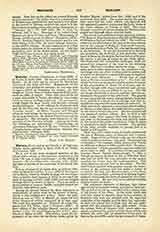

Marechal, AMBROSE, third Archbishop of Baltimore; b. at Ingres near Orleans, France, August 28, 1764; d. at Baltimore, January 29, 1828. Yielding to his parents’ desires he studied for the legal profession, but later entered the Sulpician seminary at Orleans, where he received tonsure towards the close of 1787. Owing to the chaotic condition of France, he was obliged to leave Paris for Bordeaux, where he was ordained in 1792. On the day of his ordination, and at the risk of his life, accompanied by Abbes Richard, Martignon, and Cicquard, he sailed for America and arrived at Baltimore (June 24, 1792), where he offered his first Mass. He was sent on the mission in St. Mary’s County, and later to Bohemia on the eastern shore of Maryland. In 1799, he was teaching theology at St. Mary’s College, Baltimore; in 1801 he was on the staff of Georgetown College, but after a while returned to St. Mary’s, which was then in the hands of the Sulpicians, of which order he was a member. Civil government having been restored in France under Napoleon, Father Marechal was summoned by his superiors to teach at Saint-Flour, Lyons, Aix and Marseilles. His pupils at Marseilles presented him with the marble altar which now stands in the Cathedral of Baltimore, and Louis XVIII also testified his regard by presenting him with several paintings, which also remain in Baltimore Cathedral.
In 1812 he was again teaching in Baltimore; in 1816 he was nominated Bishop of Philadelphia, but at his request the nomination was withdrawn; in 1817, on July 24, he was appointed coadjutor to Archbishop Neale of Baltimore, and Titular of Stauropolis. The Brief of appointment had not reached Baltimore when Archbishop Neale died, and the Titular of Stauropolis was consecrated Archbishop of Baltimore by Bishop Cheverus of Boston, December 14, 1817. He soon had to face serious dissensions over the claim by the laity to a voice in tie appointment of clergy; he tactfully induced his flock to yield, and established the right of the ordinary to make all such appointments. The building of the Cathedral which had been begun under Archbishop Carroll in 1806, was now resumed and completed so that the edifice was consecrated May 31, 1821. In that year Archbishop Marechal went to Rome on business of his diocese, and in connection with the White Marsh plantation which the Archbishop claimed as Diocesan property, but which had been devised to the Jesuits (February 17, 1728), and was claimed by them as property of the society to be employed in the interests of the Church of Maryland. The archbishop secured from Rome a Bull in his favor. (See Society of Jesus. in the United States.) From his “Relatio Status” for 1821-1822 we learn that in the United States as they then existed there were 9 dioceses and 117 priests, including the Archdiocese of Baltimore; which had 40 priests, 52 churches, 80,000 Catholics, 1 seminary, 1 Sulpician college, 1 Jesuit college, 1 Carmelite convent, 1 Convent of St. Vincent of Paul nuns, and 1 convent of Ursulines. In 1826 Archbishop Marechal made a journey to Canada, and on his return fell ill. His coadjutor, Rev. James Whit-field, who succeeded him as Archbishop, had not yet been consecrated when death came. His writings consist almost entirely of letters and documents scholarly in style and are to be found in “The History of the Society of Jesus in North America” by Hughes.
J. P. W. MCNEAL

